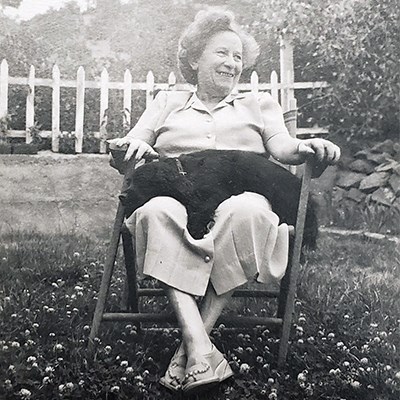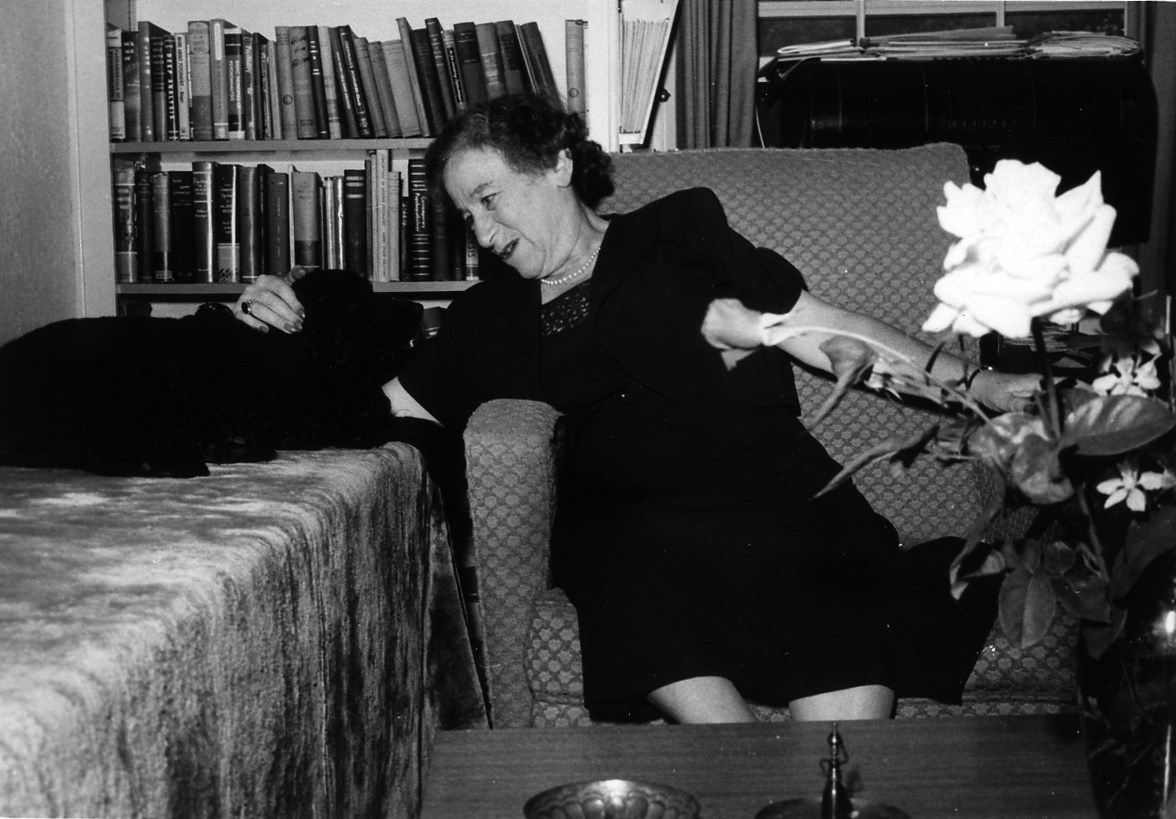Part of a series of articles titled National Register and National Historic Landmarks Celebrate Jewish Heritage Month.
Article
Frieda Fromm-Reichmann’s “Torah-peutic” Psychoanalysis

Library of Congress
Dr. Frieda Fromm-Reichmann (1889-1957) was a psychiatrist who advocated for intensive interpersonal psychotherapy for all patients - including those her colleagues considered too difficult to treat. Her cottage in Rockville, Maryland, was designated as a National Historic Landmark (NHL) in 2021, recognizing Fromm-Reichmann’s innovations in psychotherapeutic treatment.1 Her Jewish heritage shaped her therapeutic style, jokingly deemed “Torah-peutic” by patients!2
Life in Germany
Fromm-Reichmann was born in Karlsruhe, Germany, on October 23, 1889. Her parents, Adolf and Klara Reichmann, were Orthodox Jews who raised their three daughters in a long-established Jewish community and encouraged them to pursue higher education.Fromm-Reichmann attended medical school at the University of Königsberg, graduating in 1913. She studied with Dr. Kurt Goldstein, a psychiatrist who worked with patients who had experienced brain injuries. During and after World War I (1914-1918), Fromm-Reichmann treated German soldiers who had been wounded in combat.
Throughout the 1920s, Fromm-Reichmann studied psychoanalysis, reading classic texts by psychiatrists like Sigmund Freud. She absorbed key tenets of psychodynamic theory, including the central importance of the therapeutic relationship between analyst and analysand. She established a private psychiatric practice in Heidelberg, Germany, where she met and psychoanalyzed her future husband, sociologist Erich Fromm. Although the couple ultimately divorced in 1942, they remained friends, continuing to share their mutual enthusiasm for learning about the inner workings of human minds.3
Career at Chestnut Lodge in Rockville, Maryland
Fromm-Reichmann came to the United States as a refugee in 1935, fleeing Nazism. She was recruited by Dr. Dexter M. Bullard, the medical director of Chestnut Lodge, a psychiatric hospital in Rockville, Maryland. Fromm-Reichmann served as Chestnut Lodge’s director of psychotherapy for twenty-two years.
NPS Photo/Lyn Causey

Collection of Peerless Rockville.
Her tiny kitchen suggests that she wasn’t planning to cook for herself. She had most of her meals delivered from Chestnut Lodge. Not needing to prepare her own food gave her more time to spend with patients, more time to research potential promising treatments, and more time to write.
Fromm-Reichmann wrote her most well-known book, Principles of Intensive Psychotherapy, while on staff at Chestnut Lodge. The book was positively reviewed following its release, with one reviewer observing, “The masterly analysis of the doctor-patient relationship here offered is unique in its kind and can be recommended as instrumental to the understanding of any interhuman relation.”5 Her interest in addressing complex psychoses through psychoanalysis made Fromm-Reichmann’s research distinctive.
Fromm-Reichmann's Psychotherapeutic Methods
Fromm-Reichmann advocated for intensive interpersonal psychotherapy in the treatment of patients diagnosed with schizophrenia. At the time she was seeing patients, a diagnosis of “schizophrenia” was more encompassing than it is today, including symptoms that would now likely be categorized as bipolar disorder, borderline personality disorder, and depression. She also originated the now-disproved theory of the “schizophrenogenic mother,” claiming that a dysfunctional maternal relationship in early childhood was critical to the onset of schizophrenia later in life.Fromm-Reichmann’s most famous patient, Joanne Greenberg, wrote a semi-fictionalized memoir, I Never Promised You a Rose Garden (1964), based on her time in treatment with Fromm-Reichmann. Although the memoir isn’t strictly autobiographical – the character based on Fromm-Reichmann is called Dr. Fried, and the teenage protagonist is named Deborah Blau – its description of “Dr. Fried’s” psychoanalytic techniques provides insight into how Fromm-Reichmann approached psychotherapy. She prioritized building a strong therapeutic relationship between herself and her patients, trusting that every interaction could communicate meaningful truths, and letting her patients move through the therapeutic process at their own pace.
For example, one of the primary catalysts for Greenberg’s depression was the antisemitic bullying she endured as a child. Fromm-Reichmann herself was no stranger to antisemitic hatred, and their shared experiences brought them closer.6

Collection of Peerless Rockville.
Today, Fromm-Reichmann’s cottage is managed by the historic preservation group Peerless Rockville, which rents it out as a private residence. It is occasionally open to the public during special events.
1 Frieda Fromm-Reichmann Cottage, National Historic Landmark Nomination, 2021.
2 Harriet Freidenreich, “Frieda Fromm-Reichmann,” The Shalvi/Hyman Encyclopedia of Jewish Women, Jewish Women’s Archive, accessed March 8, 2024.
3 Gail A. Hornstein, To Redeem One Person Is To Redeem The World: The Life of Frieda Fromm-Reichmann (New York: The Free Press: 2000).
4 “Ann-Louise Silver on The History of Chestnut Lodge and of Frieda Fromm-Reichmann,” ISPS US, YouTube, September 21, 2021, accessed March 8, 2024.
5 Walter Riese, “New Methods Treat Ills of the Mind,” Richmond Times-Dispatch, October 29, 1950, p. 85.
6 Joanne Greenberg (pseudonym Hannah Green), I Never Promised You a Rose Garden (New York: Holt, Rinehart, & Winston), 1964.
7 “Psychiatrist Dies at Age 68: Dr. Frieda Fromm-Reichmann Succumbs to Heart Ill,” Baltimore Sun, April 30, 1957, p. 17.
Last updated: January 17, 2025
